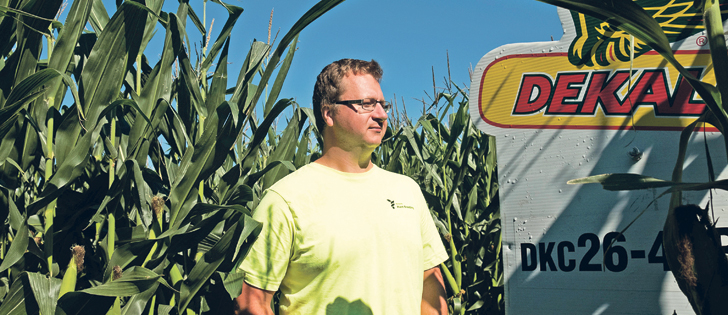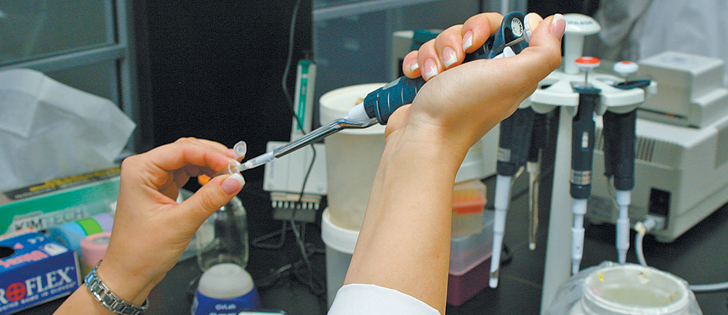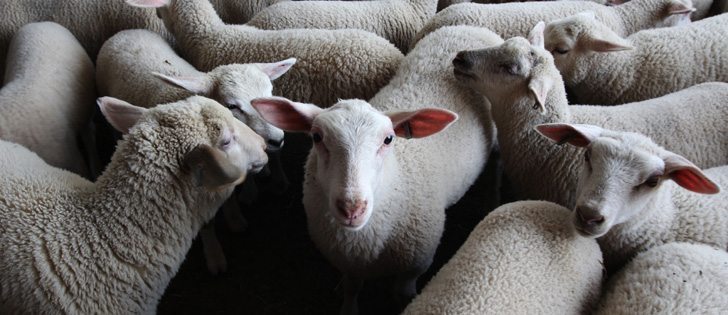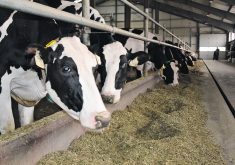CARMAN, Man. (Reuters) — Prairie summers are generally considered too short to grow a decent corn crop on a major scale.
But that’s been changing lately as the crop gradually creeps northward and westward as new crop genetics come into play.
And now agricultural giant Monsanto is developing what it hopes will be North America’s fastest-maturing corn, allowing western Canadian farmers to grow more and expanding the crop’s reach to other less hospitable climates, such as Ukraine.
The seed and chemical company projects that western Canadian corn plantings could multiply 20 times to 10 million acres by 2025, adding about 1.1 billion bushels, or nearly three percent to global production.
Read Also

Farming Smarter receives financial boost from Alberta government for potato research
Farming Smarter near Lethbridge got a boost to its research equipment, thanks to the Alberta government’s increase in funding for research associations.
The question, amid historically high supplies and low grain prices, is whether the world really needs more corn.
A global grain glut is now in its fourth year, with supplies bloated by favourable weather, increasingly high-tech farm practices and tougher plant breeds.
The bin-busting harvests of cheap corn, wheat and soybeans are undermining the business models of the world’s largest agriculture firms and the farmers who use their products and services. Some analysts say the firms have effectively innovated their way into a stubbornly oversupplied market.
Never has the world produced so much more food than can be consumed in one season. Worldwide, the end of crop-year stocks of total grains have climbed for four straight years and are poised to reach a record 638 million tonnes in 2016-17, according to data from the U.S. Department of Agriculture.
Farmers and agriculture firms could once count on periodic bouts of bad weather to tame gluts and drive up prices. But genetically modified crops that repel plant-chewing insects, withstand lethal chemicals and mature faster have made the trend toward oversupply more resistant to traditional boom-and-bust cycles.
Another key factor: China, the world’s second-biggest corn grower, adopted stockpiling policies a decade ago when crop supplies ran thin, resulting in greater production than the world needs.
“I think the norm is where we are now,” said Bryan Agbabian, director of agriculture equities at Allianz Global Investors.
Allianz investors seem to agree: The value of two agriculture equity funds that Agbabian manages fell to US$300 million this year from $800 million in 2011 as crop prices slid, he said.
Abundant supplies have helped lower food prices, but the benefit to consumers and impoverished nations is muted by several factors, including problems with corruption and distribution of food in developing regions, said Sylvain Charlebois, professor of food distribution and policy at Dalhousie University in Halifax.
The large harvests may actually harm poor communities more than they benefit their residents in food savings because lower prices depress farm incomes in the same areas, said John Baffes, a senior economist at the World Bank.
Even as farmers reap bountiful harvests, U.S. net farm incomes this year will total $63.4 billion, about half of their earnings in 2013, according to a USDA forecast.
Lower incomes mean farmers cannot spend as much on seed, fertilizer and machinery, extending their pain to firms across the agriculture sector.
PotashCorp, the world’s biggest fertilizer company by capacity, closed its newest potash mine last year, eliminating more than 400 jobs, and has seen its U.S.-listed shares fall by nearly half since the beginning of 2015. The drop erased $14 billion in value and left PotashCorp seeking to merge with rival Agrium Inc.
With profits under pressure, seed and chemical companies are scrambling to consolidate.
Monsanto’s annual profit in 2016 was its smallest in six years. It agreed last year to combine with Bayer, which would create the world’s largest integrated pesticide and seed company if the deal closes next year.
Grain handler Bunge Ltd. said this summer it would cut costs and left the door open to selling itself after posting a 34 percent drop in quarterly earnings.
Bunge chief executive officer Soren Schroder sought to reassure investors in May by saying all that was needed to trim supplies was one bad stretch of weather in the U.S. Midwest.
But the grain glut pervades many major farming regions, making it unlikely that drought or floods in one region could wipe out the mounting global surplus. Even with dry conditions in North America, Europe and Australia, the USDA forecasts that this year will bring the second-biggest global corn, wheat and soybean harvests ever.
Bunge’s Schroder made his comment about bad weather less than three weeks before confirming an informal merger approach from commodities giant Glencore.
“When prices tanked, farmers were no longer willing to pay more” for seed and chemicals, said Jonas Oxgaard, analyst at investment management firm Bernstein. “The mergers are absolutely driven by oversupply because their growth is gone.”
Monsanto spokesperson Trish Jordan said the company believes demand growth still justifies corn expansion, and she disputed the notion that crop science advances are backfiring on agricultural technology firms.
Monsanto rival Dow DuPont Inc. is making the same bet and currently sells the shortest-season field corn in North America, maturing in 70 days, spokesperson Ali Aziz said.
Success in the lab and the field, however, has contributed to oversupply and may continue to sustain it, said Oxgaard, the Bernstein analyst.
“It’s somewhat the seed companies’ fault. They keep breeding better and better seeds every year,” he said.
Charles Darwin helped plant the seeds of the grain glut. The biologist and evolution theorist showed in the late 1800s that cross-fertilization of plants, in which sex cells are fused between crop varieties of the same species, creates a more vigorous breed than those that are self-fertilized.
His work and others’ influenced successive generations of crop scientists and led to the development of hybrid corn, said Stephen Moose, a professor specializing in crop genetics at the University of Illinois.
U.S. farmers started planting the first significant acres of hybrid corn in the 1930s, and by 1950 it made up nearly all the corn seeded in the United States.
Yields exploded. Farmers who reaped 20.5 bushels of corn per acre in 1930 harvested an average of 38.2 bu. per acre in 1950, according to the USDA.
Further hybrid breeding breakthroughs generated corn with leaves that grow more erect, allowing farmers to sow it more densely without starving plants of sunlight. Yields first topped 100 bu. per acre in 1978.
After conventional breeding breakthroughs became harder to find, corn gained new vigour through the 1990s with genetic modification.
In 1996, U.S. regulators approved corn that was genetically modified to produce bug-killing proteins, accomplished by inserting a bacterium hostile to the corn borer insect into the plant genome.
Before the end of the 1990s, corn able to resist weed-killing chemical glufosinate or Monsanto’s glyphosate hit the market.
Those modified varieties and others that followed proved pivotal in generating the abundant corn crops that have since become commonplace, Moose said.
“In the seed industry, it stimulated a whole other round of investment,” Moose said.
In the 20 years since genetically modified corn reached U.S. farms, yields jumped another 37 percent to a record 174.6 bu. per acre last year.
Some experts believe the expansion of corn yields may soon hit a ceiling. The crop may be nearing the natural limit of its production potential, and crop yields will likely plateau in the next decade, based on how plants convert light to food and their ability to recover from heat, said Ken Cassman, agronomy professor at the University of Nebraska-Lincoln.
Technology has also provided better defences against pests.
Syngenta’s Viptera and Duracade traits, used to control worms and beetles, launched in 2010 and 2013. SmartStax corn seed, introduced by Monsanto and Dow in 2009, brought twin benefits of insect protection and herbicide tolerance, said Paul Bertels, vice-president of production and sustainability at the U.S. National Corn Growers Association.
The breakthroughs in seed and pesticide technologies have not come without problems. Monsanto is now embroiled in a controversy over dicamba, a big-selling chemical designed to kill weeds that harm Monsanto’s GM crops.
Many U.S. farmers say dicamba has drifted from its intended fields, damaging plants that are not resistant to the chemical. Monsanto believes the main causes of drifting are errors by farmers and applicators in deploying the herbicide, company spokesperson Charla Lord said.
As corn grew stronger, it also grew faster. Corn that required 120 days to mature in the U.S. corn belt during the 1960s now needs only 105 to 115 days.
Farmers in northern North Dakota plant and harvest corn in 80 days and have doubled the state’s production in five years.
Fast corn is now stirring the imaginations of researchers in the far north.
University of Alaska Fairbanks horticulture professor Meriam Karlsson grew hundreds of corn plants in the state in 2015.
The plants, germinated in a greenhouse before they were transplanted outside, grew from a short-season garden corn variety that matured in less than 60 days. Corn rose only four to five feet, allowing plants to spend maximum energy on growing ears, rather than leaves and stalks.
Karlsson had expected few corn plants to survive in Fairbanks, which is less than 190 kilometres from the Arctic Circle.
“It’s much more adaptable than I expected,” she said. “Amazing what breeding can do. It was kind of exciting that you could do it.”
The lure of technology comes down to money for farmers.
Even with Chicago corn futures down more than 50 percent from their 2012 record high, the high-yielding crop offers one of the strongest returns to Canadian farmers, generating profits per acre four times that of canola, based on average prices and costs, said National Bank analyst Greg Colman.
As corn spreads across the Canadian Prairies, those robust yields are winning farmers over, said Dan Wright, Monsanto Canada’s lead for corn and soybeans.
“Once you harvest corn at 140 or 180 bu., it’s something you want to do again,” he said.
The problems of plenty were on nobody’s mind less than a decade ago. In 2008, a dramatic food price run-up stirred riots from Haiti to Egypt.
Four years later, the U.S. Midwest, the engine of the global corn and soybean growing machine, suffered its worst drought in decades, opening gaping cracks in the soil and withering crops.
Chicago corn and soybean futures hit record highs as U.S. production fell to multi-year lows.
But high prices ultimately proved the cure for high prices.
Farmers in traditionally less productive corn-growing countries such as Russia, Argentina and Brazil expanded corn output to seize bigger profits.
U.S. farming quickly rebounded, reaping record corn harvests in three of the next four years.
New corn varieties have made global production more balanced than ever, with 12 countries producing at least 10 million tonnes of corn annually, up from 10 countries before the drought.
Even if U.S. or Brazilian corn crops suffered major weather damage, the world would still have the expanding Black Sea corn region to tap, not to mention China’s enormous supplies, said Bertels, of the U.S. corn growers.
China’s stockpiling policies, enacted in 2007 when corn supplies were tight, also stimulated oversupply. Aiming for self-sufficiency in grains, Beijing bought virtually the entire domestic crop each year and paid farmers as much as 60 percent more than global prices.
The program stuffed Chinese warehouses with some 250 million tonnes of corn by the time Beijing scrapped it last year. China is now boosting incentives for farmers to switch to soybeans from corn.
“The world’s corn is mainly in China,” said Li Qiang, chief consultant at Shanghai JC Intelligence Co Ltd.
He said it will take three to four years for stocks to reach a normal level of 40 to 50 million tonnes.
The Black Sea region, made up of Russia, Ukraine and Kazakhstan, has become a disruptive force with rapidly expanding exports. Moscow aims to drive grain production to 150 million tonnes by 2030 from 117 million in 2016 after increasing storage and export capacity in ports in the last couple years.
Glut conditions are expected to ease modestly this year, amid dry conditions in China and the U.S., but supplies are still so large that prices remain weak.
In northern North Dakota, an expanding frontier for corn and soybeans, Paul Thomas started dabbling in both crops about a decade ago on his farm near Minot, seeking higher returns than wheat.
Both are now among his biggest crops, including short-season Monsanto corn varieties that have been available for only a couple years.
Profits may be tougher for Thomas to eke out this year due to dry weather and soft prices, but he shrugs off the struggle.
“We’re very capable of producing a large amount of bushels given an economic incentive,” he said. “If we end up overproducing, then we shift to one that’s more in need. That’s just the way agriculture works.”
Thomas acknowledged, however, that the traditional dynamic may be changing.
“I don’t know any single crop that isn’t in oversupply,” he said.
Seeding equipment is becoming more precise, and increasingly cost-conscious farmers are applying fertilizer and chemicals more intelligently, said Al Mussell, head of research at Agri-Food Economic Systems a Canadian economic research firm.
Monsanto projects that corn will become by the mid-2020s one of the biggest crops produced in Canada, up there with current key crops canola, wheat, various pulse crops and pork.
Soybeans are also spreading across Canada where farmers seeded a record 7.3 million acres in 2017, up 75 percent in five years.
On Monsanto’s research farm in Carman, the next target is marketing a corn variety that matures in 70 days within the next two years. After that: an even quicker plant to snatch DowDuPont’s claim to North America’s fastest corn.
It is ambitious but realistic, said Kelly Boddy, manager of Monsanto’s research farm.
“Wind the clock back a few years,” he said, “and breeders wouldn’t have thought it possible.”

















